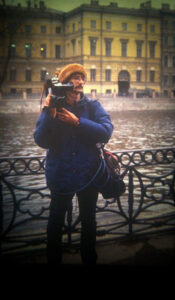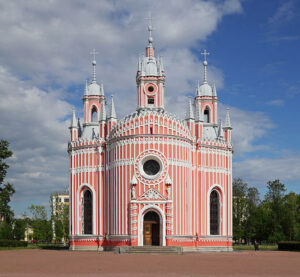
In 1982, the relationship between the governments of the Union of Soviet Socialist Republics (USSR) and America was in a deep freeze. The Berlin Wall remained as a visual reminder that an “Iron Curtain” divided Europe into two separate ideological and geographical areas. Glasnost and perestroika, openness and political reconstruction, were still a few years away for the Soviets.
The NC Friendship Force did not let these barriers keep them from attempting to thaw relations between the two mighty nations. This grass roots approach proved that common, everyday people can be ambassadors by travelling to countries meeting people on a personal level. They typically stay in the homes of families in the host country so they can experience the everyday life of the culture.
 Shelley Kofler at her desk in the newsroom.
Shelley Kofler at her desk in the newsroom.
In November 1982, WRAL News sent reporter Shelley Kofler and photographer Bruce Wittman along with 100 members of the NC Friendship Force, led by Carolyn Hunt, wife of NC Governor Jim Hunt, to visit Moscow and Leningrad (now Saint Petersburg). Extensive planning for Shelley and Bruce started several months earlier, including lessons in the Russian language. In anticipation of hauling heavy equipment around, Bruce even decided to bulk up by joining a gym.
The one thing that no one could anticipate was the timing of the death of Leonard Brezhnev, General Secretary of the Central Committee of the Communist Party of the Soviet Union. He died on November 10, 1982. After five days of mourning, he was buried on November 15. His eighteen-year term as General Secretary started in 1964. He came to power after Nikita Khrushchev – the guy who banged a shoe on the desk at the United Nations. Anytime the leader of any country dies in office, angst and uncertainty permeates the population. When it happens in a highly secretive nation, like the USSR, it folds in anxiety, paranoia, and distrust. Yuri Andropov, a former head of the KGB, rose to power on November 12. He immediately clamped down the country.
 Bruce Wittman in Russia. The hat is called a shapka. Authentic Russian hat!
Bruce Wittman in Russia. The hat is called a shapka. Authentic Russian hat!
The Friendship Force took off from New York City amidst this time of uncertainty, changed planes in Helsinki, Finland and landed in Moscow. Everyone collected their baggage, as did Bruce and Shelley. But two pieces of luggage were held back in customs; the Ikegami HL 83 camera, and the BVW 50 recorder. Back in the day, the camera and recorder were separate, but linked with a control cable. The Soviet official handed Bruce a receipt and told him that the only way he could recover the equipment would be to present the receipt at a time to be determined by the higher-ups. Bruce went into shock. This is almost the equivalent to a soldier handing over his weapon.
The 100 travelers with the North Carolinian Friendship Force, along with Kofler and Wittman, were transported to the 25 story Cosmos Hotel. It was built a couple of years earlier in 1980 for the Moscow Olympics. It has 1777 rooms and is next to the Metro (subway) Station just six stops from the Kremlin and Red Square. Bruce mentioned that it only had two elevators to service all the guests.
Right away, Shelley called WRAL and informed the managers of the seizure of the camera/recorder. Ron Price, assistant news director, started making contact with powers that be in Washington to free the Ikegami. The news room staff chanted, “Free the Ikegami! Free the Ikegami.”
Meanwhile, Bruce felt he had let everyone down, even though it was by no fault of his own. He even thought he would lose his job. Obviously he was breathing air that was already filled with paranoia. In the following days he did the only thing a traveler would normally do; go sightseeing. There were times when he felt like he was being followed by trench coat wearing KGB agents with names like Boris or Natasha. “They even smoke their cigarettes kind of funny, like a spy,” said Bruce. On November 21, he called his wife Martha to wish her a happy birthday. Bruce said, “There was a clicking noise on the phone during the entire call,” so obviously “Boris” and “Natasha” were recording all the details of the conservation and reporting back to “Fearless Leader.” By the way, the cost of the phone call was 91 dollars.
Shelley continued to stay in touch with Ron back in Raleigh while the Friendship Force visited Soviet families in their homes. Phone calls to the US State Department yielded nothing. Meanwhile, the 100 members of the Friendship Force said they would not leave until the camera/recorder was returned to the news crew. Ron was determined to free the Ikegami camera/BVW 50 from its hostage location. It occurred to him that Scottie Stephenson, long time corporate secretary and member of the CBC Board of Directors, could contact Senator Jesse Helms, a former CBC employee. It just so happen that he was in Moscow, as well as Kansas Senator Bob Dole and NC Congressman James Broyhill. A triumvirate! SCORE! It was kindly pointed out to the Soviets that WRAL had a reporter and photographer in Moscow with the Friendship Force. The main focus of the visit was to document the kindness and generosity of the Soviet people. Suddenly the shackles fell off of the camera and recorder after four days of captivity. Bruce hopped into a cab, with his valuable receipt clutched tightly in his hand, and raced to the airport to retrieve the Ikegami camera/BVW-50 recorder.
 Bruce Wittman at the Negev River in Leningrad.
Bruce Wittman at the Negev River in Leningrad.
As soon as Bruce had his gear, he hailed a cab and arrived at the train station in time to meet up with the Friendship Force as they were boarding the midnight train to Leningrad, now Saint Petersburg. While in the cab, Bruce was able to grab a 15 second shot of Red Square, his only shot of Moscow.
Now Shelley and Bruce are in their element doing what they do so well; report and capture video. In Leningrad they made up for lost time. Bruce said the atmosphere was much different than Moscow. They were provided with a driver who showed them around the historic city. One stop included a school where many of the teenage students spoke English. When Shelley asked the question, “Which country would you prefer to live in; the Soviet Union or America?” The predictable answer was, “Soviet Union.” As to why, the answer was interesting. The students explained that the USSR has one government and America has three. After a little head scratching, Shelley and Bruce realized that the youngsters did not fully understand the American concept of federal, state, and local government.
Without question, the most impactful story that tugged on the emotional heart strings of everyone was the visit to a graveyard in Leningrad. One of the members of the Friendship Force, Lydia White, honored the memory of her grandmother who died during the “900 Day Siege” during WWII. German troops encircled Leningrad in September 1941 and the siege began. The city’s almost 3 million civilians, including 400,000 children, refused to surrender to the Nazi army. Cold, starvation, inhumane conditions, and the tragic loss of the population took its toll, however Leningrad never surrendered.
The image of Lydia walking to her grandmother’s grave is forever etched into Bruce’s memory. He respectfully shot the video from a distance, as Lydia knelt down and wept. No words necessary. Forty years later, the full weight of the necessity of a Friendship Force was on full display.
 Chesme Church in Leningrad
Chesme Church in Leningrad
Other stops for the group included a visit to the Church of the Birth of St. John the Baptist (Chesme Church) with its stunning architecture that resembles a wedding-cake structure with five gothic turrets in place of traditional onion domes. The Museum Hermitage, former home of Peter the Great, provided another accolade for WRAL News. According to the officials at Hermitage, WRAL was the first American news crew allowed to shoot video of the interior. Even Bruce wondered if that is something they told every news crew, no matter the country.
The Friendship Force traveled to Helsinki, Finland and boarded their flight back to New York City and ultimately Raleigh. Bruce made up for the time lost in Moscow by interviewing members of the Friendship Force during the long flight. As Bruce’s luck, or lack of, continued – his battery died. He was not permitted to recharge his batteries while inflight due to concerns of fire. However, he had enough video to tell the story of the unforgettable adventure behind the Iron Curtain.
Glasnost and perestroika, under General Secretary Gorbachev, provided the crack to bring down the Union of Soviet Socialist Republics. The USSR ceased to exist on December 26, 1991. A few months later, WRAL News anchor Donna Gregory and photographer Jay Jennings accompanied another Friendship Force to the Russia. Stay tuned for their adventures in a future Throwback Thursday article.
With clanging, creaking, and squeaking, an iron curtain is lowering over Russian History. “The performance is over.” The audience got up. “‘Time to put on your fur coats and go home.” We looked around, but the fur coats and homes were missing.
–Vasily Rozanov’s, The Apocalypse of Our Times. 1918
“Mr. Gorbachev, Tear Down this Wall.”
–President Ronald Reagan, June 12, 1987
Thanks to Corp’s Pam Allen for this capcom story & these photos. Pam Parris Allen is a former WRAL newscast producer/director who now works as a researcher and producer on the CBC History Project.